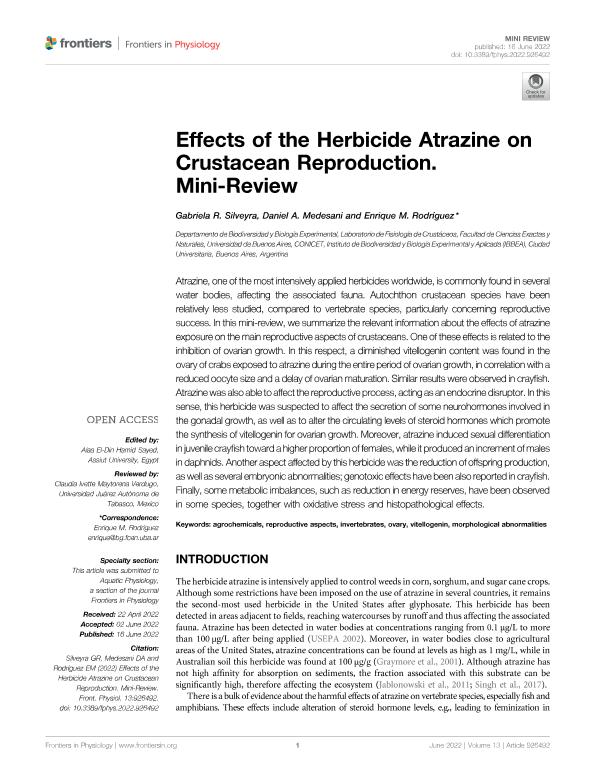Artículo
Effects of the Herbicide Atrazine on Crustacean Reproduction: Mini-Review
Fecha de publicación:
06/2022
Editorial:
Frontiers Media
Revista:
Frontiers in Physiology
ISSN:
1664-042X
Idioma:
Inglés
Tipo de recurso:
Artículo publicado
Clasificación temática:
Resumen
Atrazine, one of the most intensively applied herbicides worldwide, is commonly found in several water bodies, affecting the associated fauna. Autochthon crustacean species have been relatively less studied, compared to vertebrate species, particularly concerning reproductive success. In this mini-review, we summarize the relevant information about the effects of atrazine exposure on the main reproductive aspects of crustaceans. One of these effects is related to the inhibition of ovarian growth. In this respect, a diminished vitellogenin content was found in the ovary of crabs exposed to atrazine during the entire period of ovarian growth, in correlation with a reduced oocyte size and a delay of ovarian maturation. Similar results were observed in crayfish. Atrazine was also able to affect the reproductive process, acting as an endocrine disruptor. In this sense, this herbicide was suspected to affect the secretion of some neurohormones involved in the gonadal growth, as well as to alter the circulating levels of steroid hormones which promote the synthesis of vitellogenin for ovarian growth. Moreover, atrazine induced sexual differentiation in juvenile crayfish toward a higher proportion of females, while it produced an increment of males in daphnids. Another aspect affected by this herbicide was the reduction of offspring production, as well as several embryonic abnormalities; genotoxic effects have been also reported in crayfish. Finally, some metabolic imbalances, such as reduction in energy reserves, have been observed in some species, together with oxidative stress and histopathological effects.
Archivos asociados
Licencia
Identificadores
Colecciones
Articulos(IBBEA)
Articulos de INSTITUTO DE BIODIVERSIDAD Y BIOLOGIA EXPERIMENTAL Y APLICADA
Articulos de INSTITUTO DE BIODIVERSIDAD Y BIOLOGIA EXPERIMENTAL Y APLICADA
Citación
Silveyra, Gabriela Romina; Medesani, Daniel Alberto; Rodriguez, Enrique Marcelo; Effects of the Herbicide Atrazine on Crustacean Reproduction: Mini-Review; Frontiers Media; Frontiers in Physiology; 13; 6-2022; 1-5
Compartir
Altmétricas




